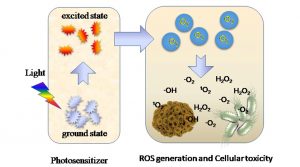Phototherapy was discovered centuries ago in ancient Greece and Egypt, but its medicinal applications have flourished in recent years with advances made in photochemistry, materials science, and nanotechnology.
Photodynamic therapy (PDT) is a photo-medicine used in the treatment of cancer and infectious diseases. PDT employs light to activate a photosensitizer, located in the body, that destroys tumor cells or pathogens by generating radical oxygen species (ROS). A prominent example is Photofrin (Porfimer sodium), which is clinically used to treat esophageal cancer and non-small cell lung cancer as it is less toxic, non-invasive, and costs less than other forms of cancer therapy. PDT has also found application in fighting bacterial infections, which are currently a serious global threat due to exponentially increasing rates of antimicrobial resistance.

In a recent review published in WIREs Nanomedicine and Nanobiotechnology, Prof. Zhenjia Wang and coworkers from Washington State University have presented recent advances in the design of new photosensitizers and new nanomaterials to improve current therapies in cancer and infectious diseases.
The authors discuss new technologies used in generating photosensitizers with increased production of radical oxygen species (ROS), and advances made in genetically engineered biological photosensitizers used to study cellular signaling pathways. This includes exciting applications of PDT in treating bacterial infections, showing it is possible to overcome the growing issue of antimicrobial resistance.
The review also discusses an interesting new concept, wherein the tumor microenvironment can be manipulated through PDT to initiate neutrophil transmigration from the blood stream to tumor tissues. Neutrophils are the most abundant circulating white blood cells in humans, with 100 billion neutrophils circulated throughout the body per day. Hijacking neutrophils to deliver therapeutics is a promising approach to treat cancer, and using nanoparticles to target activated neutrophils for targeted delivery in tumors has established a new research direction to treat a wide range of cancers.
New developments in nanotechnology, materials engineering, and immunology offer a broad platform for PDT to improve current cancer and antimicrobial therapies.
Kindly contributed by the Authors.
















